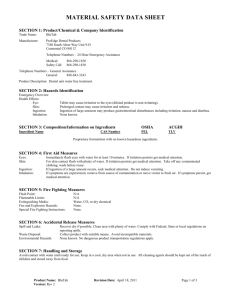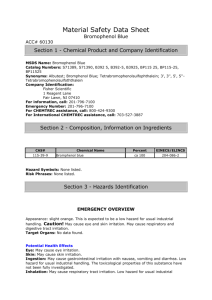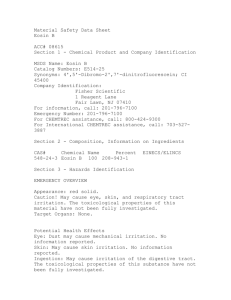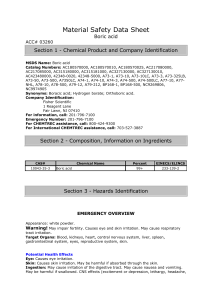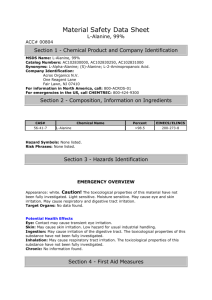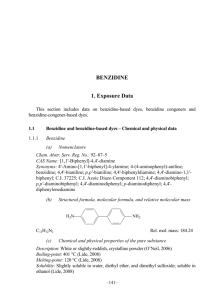Material Safety Data Sheet
advertisement
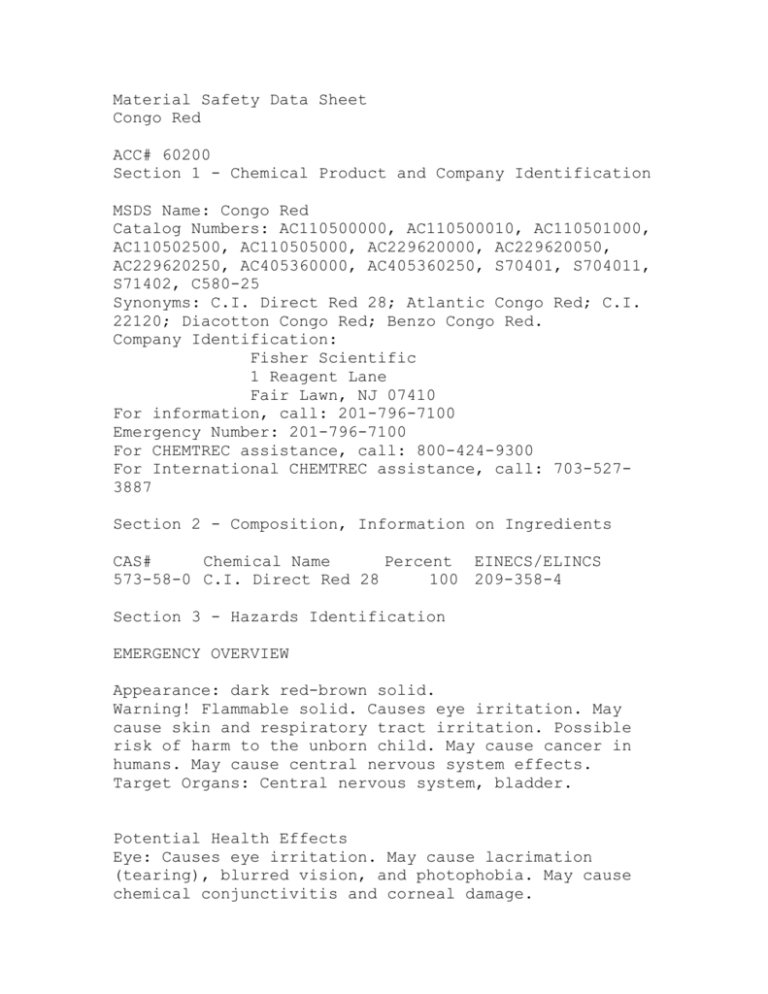
Material Safety Data Sheet Congo Red ACC# 60200 Section 1 - Chemical Product and Company Identification MSDS Name: Congo Red Catalog Numbers: AC110500000, AC110500010, AC110501000, AC110502500, AC110505000, AC229620000, AC229620050, AC229620250, AC405360000, AC405360250, S70401, S704011, S71402, C580-25 Synonyms: C.I. Direct Red 28; Atlantic Congo Red; C.I. 22120; Diacotton Congo Red; Benzo Congo Red. Company Identification: Fisher Scientific 1 Reagent Lane Fair Lawn, NJ 07410 For information, call: 201-796-7100 Emergency Number: 201-796-7100 For CHEMTREC assistance, call: 800-424-9300 For International CHEMTREC assistance, call: 703-5273887 Section 2 - Composition, Information on Ingredients CAS# Chemical Name Percent EINECS/ELINCS 573-58-0 C.I. Direct Red 28 100 209-358-4 Section 3 - Hazards Identification EMERGENCY OVERVIEW Appearance: dark red-brown solid. Warning! Flammable solid. Causes eye irritation. May cause skin and respiratory tract irritation. Possible risk of harm to the unborn child. May cause cancer in humans. May cause central nervous system effects. Target Organs: Central nervous system, bladder. Potential Health Effects Eye: Causes eye irritation. May cause lacrimation (tearing), blurred vision, and photophobia. May cause chemical conjunctivitis and corneal damage. Skin: May cause skin irritation. May cause skin sensitization, an allergic reaction, which becomes evident upon re-exposure to this material. May cause skin irritation and possible burns. Ingestion: May cause gastrointestinal irritation with nausea, vomiting and diarrhea. May cause nausea, vomiting, abdominal pain, and increased salivation. Inhalation: May cause respiratory tract irritation. Olfactory fatigue may occur. Can produce delayed pulmonary edema. Chronic: This product is a chemical derivative of benzidine, a known human carcinogen. This substance has caused adverse reproductive and fetal effects in laboratory animals. The primary target organs for carcinogenicity induced by benzidine vary with species. Rats, mice, and hamsters develop liver and mammary tumors. Dogs and humans develop increased incidences of urinary bladder cancer. Section 4 - First Aid Measures Eyes: In case of contact, immediately flush eyes with plenty of water for a t least 15 minutes. Get medical aid. Skin: In case of contact, flush skin with plenty of water. Remove contaminated clothing and shoes. Get medical aid if irritation develops and persists. Wash clothing before reuse. Ingestion: If swallowed, do not induce vomiting unless directed to do so by medical personnel. Never give anything by mouth to an unconscious person. Get medical aid. Inhalation: If inhaled, remove to fresh air. If not breathing, give artificial respiration. If breathing is difficult, give oxygen. Get medical aid. Notes to Physician: Treat symptomatically and supportively. Section 5 - Fire Fighting Measures General Information: As in any fire, wear a selfcontained breathing apparatus in pressure-demand, MSHA/NIOSH (approved or equivalent), and full protective gear. During a fire, irritating and highly toxic gases may be generated by thermal decomposition or combustion. This material in sufficient quantity and reduced particle size is capable of creating a dust explosion. Flammable solid. May burn rapidly with flare burning effect. May re-ignite after fire is extinguished. Extinguishing Media: Contact professional fire-fighters immediately. Cool containers with flooding quantities of water until well after fire is out. Use water spray, dry chemical, carbon dioxide, or appropriate foam. Flash Point: Not applicable. Autoignition Temperature: Not applicable. Explosion Limits, Lower:Not available. Upper: Not available. NFPA Rating: (estimated) Health: 2; Flammability: 2; Instability: 0 Section 6 - Accidental Release Measures General Information: Use proper personal protective equipment as indicated in Section 8. Spills/Leaks: Vacuum or sweep up material and place into a suitable disposal container. Clean up spills immediately, observing precautions in the Protective Equipment section. Scoop up with a nonsparking tool, then place into a suitable container for disposal. Avoid generating dusty conditions. Remove all sources of ignition. Provide ventilation. Section 7 - Handling and Storage Handling: Wash thoroughly after handling. Remove contaminated clothing and wash before reuse. Use with adequate ventilation. Minimize dust generation and accumulation. Avoid contact with eyes, skin, and clothing. Empty containers retain product residue, (liquid and/or vapor), and can be dangerous. Keep container tightly closed. Keep away from heat, sparks and flame. Avoid ingestion and inhalation. Do not pressurize, cut, weld, braze, solder, drill, grind, or expose empty containers to heat, sparks or open flames. Storage: Keep away from heat, sparks, and flame. Keep away from sources of ignition. Store in a cool, dry place. Keep containers tightly closed. Section 8 - Exposure Controls, Personal Protection Engineering Controls: Facilities storing or utilizing this material should be equipped with an eyewash facility and a safety shower. Use adequate ventilation to keep airborne concentrations low. Use adequate general or local explosion-proof ventilation to keep airborne levels to acceptable levels. Exposure Limits Chemical Name ACGIH NIOSH OSHA - Final PELs C.I. Direct Red 28 none listed none listed none listed OSHA Vacated PELs: C.I. Direct Red 28: No OSHA Vacated PELs are listed for this chemical. Personal Protective Equipment Eyes: Wear appropriate protective eyeglasses or chemical safety goggles as described by OSHA's eye and face protection regulations in 29 CFR 1910.133 or European Standard EN166. Skin: Wear appropriate protective gloves to prevent skin exposure. Clothing: Wear appropriate protective clothing to prevent skin exposure. Respirators: A respiratory protection program that meets OSHA's 29 CFR 1910.134 and ANSI Z88.2 requirements or European Standard EN 149 must be followed whenever workplace conditions warrant respirator use. Section 9 - Physical and Chemical Properties Physical State: Solid Appearance: dark red-brown Odor: odorless pH: 8-9.5 (aq soln) Vapor Pressure: Negligible. Vapor Density: Not available. Evaporation Rate:Negligible. Viscosity: Not available. Boiling Point: Not available. Freezing/Melting Point:> 360 deg C Decomposition Temperature:Not available. Solubility: Soluble. Specific Gravity/Density:Not available. Molecular Formula:C32H22N6O6S2Na2 Molecular Weight:696.67 Section 10 - Stability and Reactivity Chemical Stability: Stable at room temperature in closed containers under normal storage and handling conditions. Materials containing similar functional groups can decompose at elevated temperatures. Conditions to Avoid: Incompatible materials, ignition sources, dust generation, excess heat. Incompatibilities with Other Materials: Strong oxidizing agents, strong acids. Hazardous Decomposition Products: Carbon monoxide, oxides of nitrogen, oxides of sulfur, carbon dioxide. Hazardous Polymerization: Will not occur. Section 11 - Toxicological Information RTECS#: CAS# 573-58-0: QK1400000 LD50/LC50: CAS# 573-58-0: Draize test, rabbit, eye: 100 mg Moderate; Oral, rat: LD50 = 15200 mg/kg; . Carcinogenicity: CAS# 573-58-0: * ACGIH: Not listed. * California: carcinogen, initial date 10/1/92 (listed as Benzidine based dyes). * NTP: Known carcinogen (listed as Benzidine based dyes). * IARC: Group 2A carcinogen (listed as Benzidine based dyes). Epidemiology: A strong association relating human exposure to benzidine based dyes with the subsequent development of bladder tumors was presented after a case-control mortality study of 200 bladder cancer patients in Japan. Patients were mostly kimono painters/dyers Teratogenicity: C.I. Direct Black 38, a benzidine-based dye, was evaluated for developmental toxicity. All dose levels caused a significant increase in the average % of malformed fetuses. Malformed centra were significantly increased at 200 mg/kg/day and above. Reproductive Effects: In mice and rats, prenatal exposure to the dye Congo red, a benzidine-based dye, permanently reduces the number of germ cells in male and female offspring.In 1 study, the administration of benzidine to pregnant mice produced liver tumors in the offspring. Oral doses of benzidine-based dyes to pregnant mice on Day 8-12 of gestation altered testicular development & caused hypospermatogenesis during adulthood Mutagenicity: See actual entry in RTECS for complete information. Neurotoxicity: No data available. Other Studies: Section 12 - Ecological Information No information available. Section 13 - Disposal Considerations Chemical waste generators must determine whether a discarded chemical is classified as a hazardous waste. US EPA guidelines for the classification determination are listed in 40 CFR Parts 261.3. Additionally, waste generators must consult state and local hazardous waste regulations to ensure complete and accurate classification. RCRA P-Series: None listed. RCRA U-Series: None listed. Section 14 - Transport Information US DOT Canada TDG Shipping Name: FLAMMABLE SOLIDS, ORGANIC, N.O.S. FLAMMABLE SOLIDS, ORGANIC, N.O.S. Hazard Class: 4.1 4.1 UN Number: UN1325 UN1325 Packing Group: II II Section 15 - Regulatory Information US FEDERAL TSCA CAS# 573-58-0 is listed on the TSCA inventory. Health & Safety Reporting List None of the chemicals are on the Health & Safety Reporting List. Chemical Test Rules None of the chemicals in this product are under a Chemical Test Rule. Section 12b CAS# 573-58-0: Section 5 TSCA Significant New Use Rule CAS# 573-58-0: This product is for research and development use only. It is subject to a SNUR which has specific requirements and restrictions. The specific citation for this product is 4040 CFR 721.1660. CERCLA Hazardous Substances and corresponding RQs None of the chemicals in this material have an RQ. SARA Section 302 Extremely Hazardous Substances None of the chemicals in this product have a TPQ. SARA Codes CAS # 573-58-0: immediate, delayed. Section 313 No chemicals are reportable under Section 313. Clean Air Act: This material does not contain any hazardous air pollutants. This material does not contain any Class 1 Ozone depletors. This material does not contain any Class 2 Ozone depletors. Clean Water Act: None of the chemicals in this product are listed as Hazardous Substances under the CWA. None of the chemicals in this product are listed as Priority Pollutants under the CWA. None of the chemicals in this product are listed as Toxic Pollutants under the CWA. OSHA: None of the chemicals in this product are considered highly hazardous by OSHA. STATE CAS# 573-58-0 can be found on the following state right to know lists: California, (listed as Benzidine based dyes), New Jersey, Minnesota, (listed as Benzidine based dyes). California Prop 65 The following statement(s) is(are) made in order to comply with the California Safe Drinking Water Act: WARNING: This product contains C.I. Direct Red 28, listed as `Benzidine based dyes', a chemical known to the state of California to cause cancer. California No Significant Risk Level: None of the chemicals in this product are listed. European/International Regulations European Labeling in Accordance with EC Directives Hazard Symbols: T F Risk Phrases: R 11 Highly flammable. R 45 May cause cancer. R 63 Possible risk of harm to the unborn child. Safety Phrases: S 45 In case of accident or if you feel unwell, seek medical advice immediately (show the label where possible). S 53 Avoid exposure - obtain special instructions before use. S 7 Keep container tightly closed. S 43I In case of fire, use dry chemical, CO2, water spray or foam. ( These chemicals have very low flashpoints and the use of water spr ay may be inefficient). WGK (Water Danger/Protection) CAS# 573-58-0: 1 Canada - DSL/NDSL CAS# 573-58-0 is listed on Canada's DSL List. Canada - WHMIS This product has a WHMIS classification of D2B, D2A. This product has been classified in accordance with the hazard criteria of the Controlled Products Regulations and the MSDS contains all of the information required by those regulations. Canadian Ingredient Disclosure List CAS# 573-58-0 is not listed on the Canadian Ingredient Disclosure List. Section 16 - Additional Information MSDS Creation Date: 5/20/1998 Revision #7 Date: 10/27/2006 The information above is believed to be accurate and represents the best information currently available to us. However, we make no warranty of merchantability or any other warranty, express or implied, with respect to such information, and we assume no liability resulting from its use. Users should make their own investigations to determine the suitability of the information for their particular purposes. In no event shall Fisher be liable for any claims, losses, or damages of any third party or for lost profits or any special, indirect, incidental, consequential or exemplary damages, howsoever arising, even if Fisher has been advised of the possibility of such damages.



